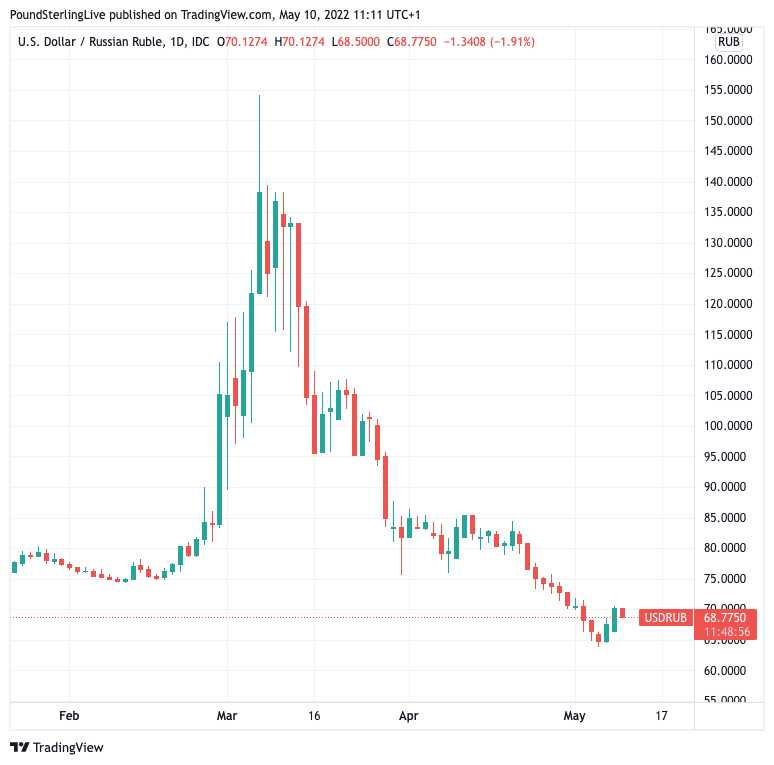A Strengthening Ruble Belies a Russian Import Crisis
- Written by: Gary Howes
-

Image © Adobe Stock
The Russian Ruble is strengthening, but this is not a sign of economic strength and is in fact symptomatic of what can best be described as an import crisis.
The Ruble plunged when Russia invaded Ukraine in February and Western nations responded with swingeing sanctions.
But, it has since recovered to above pre-invasion levels and couldbe set to move higher in the near-term.
"I've been asked a bunch about the ruble lately and why we're at stronger levels than we were pre-sanctions," says Bipan Rai, Head of North America FX Strategy at CIBC Capital Markets.
"Long story short - it's a mirage and definitely not because the Russian economy is strong or that Putin is 'winning' at the sanctions game," he adds.
Above: USD/RUB at daily intervals.
Russia's imports have collapsed under the weight of sanctions with specific sectors being directly targeted for bans by western countries.
But even sectors and companies not directly subject to the sanctions have opted to step back from Russia for fear of indirectly flouting sanctions imposed by the U.S. and European Union.
The scale of the collapse in Russian imports was made abundantly clear when Germany released its latest set of trade data.
Destatis said on May 03 that compared with February 2022, exports to the Russian Federation decreased by 62.3% to 0.9BN euros in March 2022 owing of the sanctions imposed as a result of Russia's invasion of Ukraine.
But Germany's imports from Russia declined by just 2.4% to 3.6BN euros in the same period.
The inelastic nature of Germany's imports from Russia reflects the country's significant dependency on Russian hydrocarbons, particularly gas and oil.
"Consider the following - Russia is importing far less than they did pre-invasion due to sanctions. But it's still exporting its oil/gas to its biggest clients. Ergo, its current account position is in surplus. That puts upward pressure on its currency," says Rai.
Looking ahead, it is gas and oil exports that hold the key to how long the Ruble can stay elevated.
"This is why the oil ban is a big deal for the Russian economy and likely means that the end of the RUB rally is nigh," says Rai.
The U.S. has banned Russian oil while the UK has set a deadline for year-end for a complete ban.
The EU - a larger market - is however struggling to come up with a timeline to implement a complete ban.
The majority of EU nations are in favour of a year-end ban but Hungary and other Eastern European countries are holding out.
Nevertheless, negotiations are ongoing and a deal will likely eventually be reached.
Analysts at Goldman Sachs point out that capital controls imposed by Russia add to what amounts to a "tenuous but currency supportive equilibrium".
"The Ruble has continued to strengthen in both offshore and onshore markets as a consequence of a powerful combination of strong energy export revenues and collapsing imports on the one hand, and capital controls that prevent international and local investors from expatriating any stranded hard currency assets," says Zach Pandl, Co-Head of FX Strategy at Goldman Sachs.
Pandl adds that Russia's willingness to use hard currency to avoid sovereign default for now has also helped to forestall a fresh bout of pressure on the currency.
But from here Goldman Sachs says the outlook for the Ruble remains highly uncertain.
Pandl says the proposed phased end to Russian oil exports to Europe is likely to start pressuring Russia's hard currency inflows but only very gradually, suggesting that the currency can continue to trade at firm levels for now.
Goldman Sachs tell clients risks to the Ruble remain high, especially as the contraction of the economy becomes more apparent with time.







